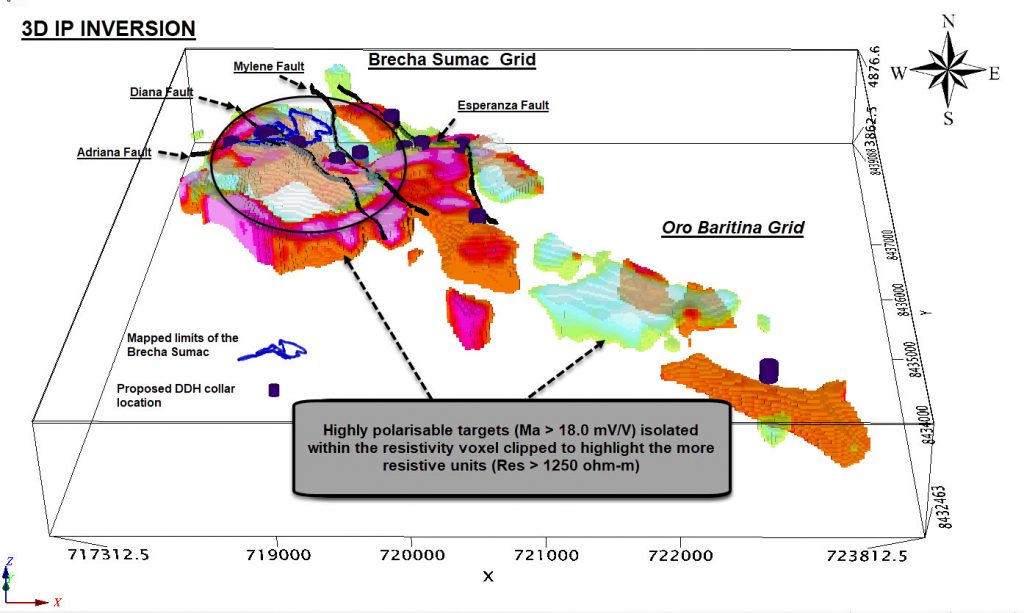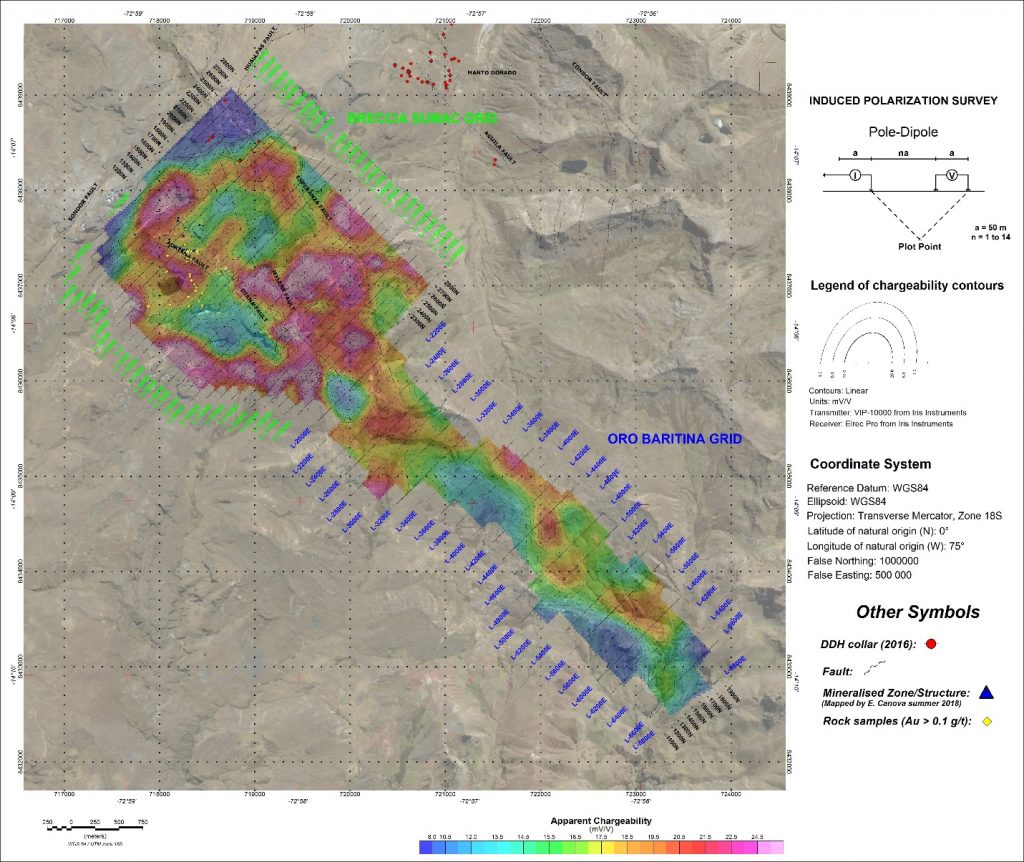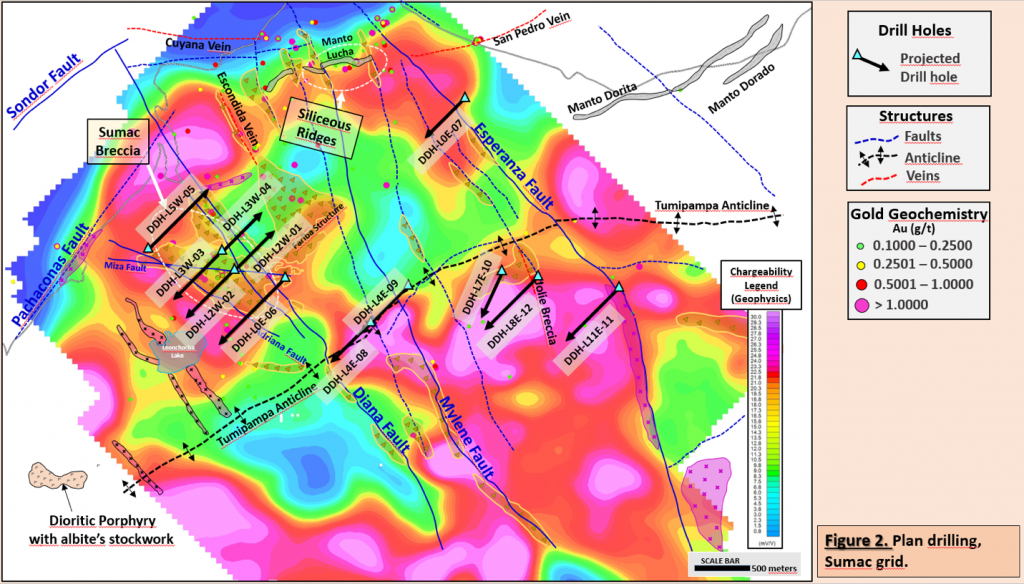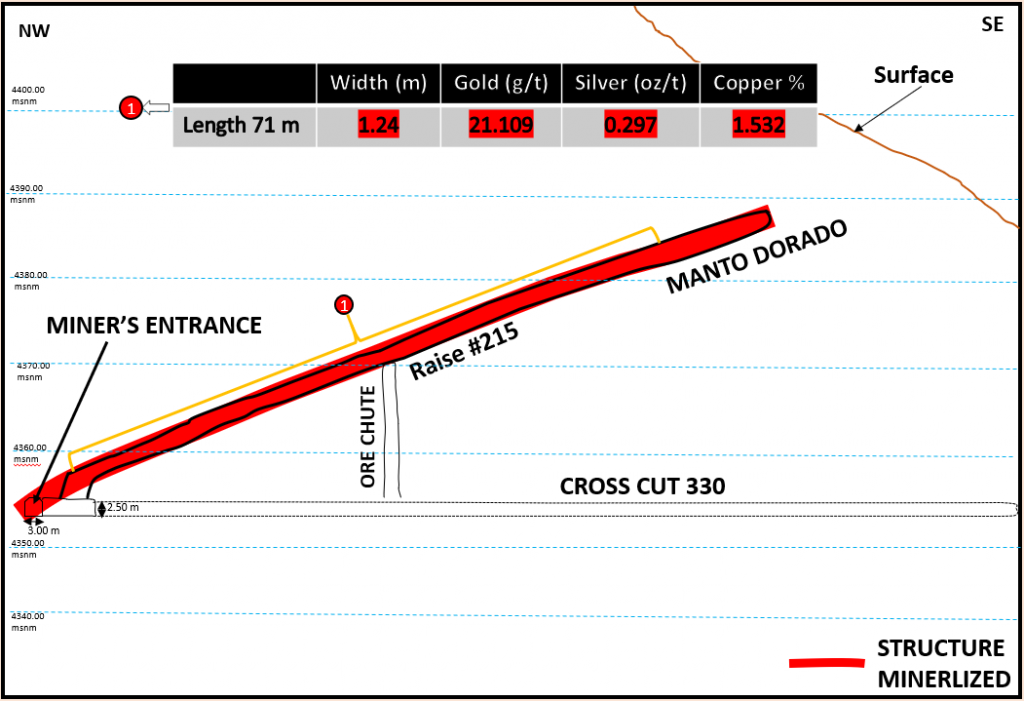Property Description and Ownership
The property is located 60 km south of the city of Abancay in the Tumipampa region, Circa District, province of Abancay, Apurimac department and about 500 km southeast of Lima. The altitude varies between 4200 and 4800 meters. Dynacor Gold Mines of Peru holds the titles and the permits in good standing on this property of 9756 hectares. The coordinates of the approximate centre of the property are (UTM PSAD 56 Zone 18S) 720,000 E and 8,440,000 N.
The morphology of the property is of the occidental Andes Cordillera of Peru. The average altitude is 4,500 meters above sea level with a mountainous relief, large surface areas, which are locally covered with glacial deposits and moraine. The camp on the property was expanded in 2014 which provides living facilities for 40 persons.
March 1, 2019:
GEOPHYSICAL SURVEY RESULTS: (see figures 1 & 2)
The decision to survey was taken in March 2018 and was conducted by Valdor Sudamérica SAC. An IP (induced Polarization) geophysics survey was outlined to cover the disseminated zone which includes the Breccia Sumac, the Oro Baritina grid, and other mineralized quartzites zones of Tumipampa.
The IP survey area:
- 102.45 km (kilometres)
- 74.10 km on the Breccia Sumac grid (disseminated zone)
- 28.35 km on the Oro Baritina grid (located in the new claims south of the Breccia Sumac)
The geophysical team began surveys on May 15, 2018, completing the Breccia Sumac grid on October 5, 2018, and the Oro Baritina grid on October 26, 2018.
The IP on the Breccia Sumac Grid outlined positive geophysical results associated with both high chargeability and resistivity anomalies.
- Chargeability: Line L500W to line L0E with possible extension to line L400E
- A 500-900 m (meter) strike length of anomalies
- 100-300 m wide with depths of 200-300 m
The chargeability anomalies coincide with the previous surface channel sample anomalies returning values of 1.00 g/t Au to 35.58 g/t Au. (see news release February 27, 2015)
Figure 1: 3D Image of Chargeability Anomalies and Drill Targets (Purple collars)

Figure 2: IP Geophysics Sumac Grid Chargeability Anomalies (Orange to Pink) and Location of Manto Dorado

PLANNED DRILLING
- The first phase of twelve (12) holes:
- Totalling 4410 meters
- Priority 1 targets to be 2910 m (8 holes)
- Priority 2 targets to be 1500 m (4 holes)
Priority 1 Targets (Disseminated Zone)
Breccia Sumac: The positive geophysical and surface channel results have defined six (6) shallow high priority drill targets on the Breccia Sumac. The drill targets are plotted to intersect with the highest value geophysical readings and surface channel location reporting high anomaly of gold results collected in the past.
The Breccia Sumac drill targets:
- To drill chargeability anomalies near the surface
- Down to 300 m on the lines L0, L200W, L300W, L525W and L400E
Esperanza Fault: One (1) high-priority drill target due to the positive geophysical result related to the extension of the Esperanza Fault.
- To drill chargeability and resistivity anomalies near the surface
- Down to 200 m on the line L0E
Diana Fault: One (1) additional high priority drill target is defined in the Diana Fault which may be related to the Breccia Sumac anomalies.
- To drill chargeability and resistivity anomalies near the surface
- Down to 300 m on the line L400E
Priority 2 Targets
Four additional (4) drill targets totalling 1500 m will test other high geophysical anomalies along the sections L400E, L700E, L800E and L1100E.
The planning of the phase two drilling program will commence after the reception of the assay results from the first phase.
Figure 3: Planned Drill Target Map (12 holes)

Dynacor is working with a well-organized artisanal mining team from the community of Pachaconas to start extracting gold mineralized material from the high-grade underground vein system developed at Tumipampa. In December 2017, the Pachaconas community granted Dynacor a right-of-way agreement to access the disseminated mineralized zone with diamond drill rigs.
A working plan was reached by both parties. The artisanal miners will be allowed to extract mineralized material from a 71-meter long raise averaging 21.109 g/t Au directly above the Manto Dorado. (see figure 4)
As part of the working plan , Dynacor will purchase the mineralized material from the artisanal miners which will then be processed at its Veta Dorada plant in Chala, in Peru.
Upon final approval by both parties, Dynacor will publish a news release.
Figure 4: Cross Sectional View Of 71-Meter Long Raise

On the Tumipampa property, the geology consists of igneous, sedimentary and metamorphic rocks. The intrusive unit consists of the Apurimac batholith, which is locally also named Andahuaylas-Yauri and its apophysis as well as the recently identified small “el Potro” porphyry system. Quaternary moraine deposits are common in low valleys and basins, some of which are of significant thickness.
The sedimentary rocks consist of limestones of the Ferrobamba Formation of Albiano-Cenomanian age of the middle Cretaceous period. They are of dark grey colour and are mostly concentrated in the north north-west part of the property. The limestones are concordant and overlie the quartzites of the Soraya Formation.
The metamorphic rocks are quartzite units, which are part of the Soraya Formation of Lower Cretaceous age. They consist of white to beige, fine to medium grain size with local levels of coarse grain size when silicified. There are several faults and fractures with local brecciated zones that have shown to be anomalous in gold. The quartzites are found on most parts of the property. Some quartzite units are sericitized grey in colour with quartz-sericite-pyrite representing total destruction of the matrix. These altered quartzite units are called metasomatites.
Igneous Rocks consist of granodiorites and diorites of the Apurimac batholith, which intrude into the limestones and the quartzites with local moderate to intense argillic alteration. The massive intrusive units outcrop as small bodies between quartzite units and are recognized at depth in diamond drillholes TCD-04 and TCD-06.
The recently identified “el Potro” porphyry system consists of a fine medium textured dioritic intrusive with a NW elongation and surrounded by limestones. Most of the porphyry intrusive shows chloritic alteration and including local narrow propylitic alteration. At the contact with the surrounding limestones, pervasive exoskarn alteration is observed in places, and cut by numerous crosscutting narrow dacitic dykes.
The porphyry is penetrated by several quartz-magnetite veinlets and tiny chalcopyrite veinlets and associated quartz veinlets were also observed on outcrops.
The “el Potro” porphyry system shows weak to moderate chargeability and magnetic responses whereas the surrounding host skarn shows narrow E-W elongated low chargeability anomaly axises.
From 2012 to June 2016, a total of 2,571 underground channel samples had been taken in chimneys, galleries and sub-levels. This sampling was mainly completed within the Manto Dorado, Manto Nazareno, Manto Nelly, Veta 1 and Veta Lisa.
Geophysical
The purpose of the geophysical survey (2014) was to extend towards the South the Mag and IP surveys completed in 2011 by Val-d’Or Geophysical. The selected zone covers an area of 4 kilometers E-W by 2.4 kilometers N-S. The implemented grid consists of 13 E-W oriented lines spaced every 200 meters. The magnetic readings were done in GPS assisted navigation mode. The IP survey only covered the northern 2/3 of the grid. In 2016 a report on the processing and interpretation of ground geophysical data performed on the Tumipampa Property was completed. All in all, a total of 23 Mag and 34 IP anomalies were identified and based on the results of the processing and interpretation of the raw data.
Recent Drilling
The company received its exploration permit in December 2012 and initiated a drilling program on the Skarn 4 area and start of a cross-cut through the Manto Dorado of 298.23 meters.
From 2012 to 2015, four (4) drilling programs were completed on the Tumipampa Property, totaling 12,616.30 meters (including surface and underground). The drill core samples were assayed by Certimin S.A. Laboratory in Lima (Peru) and ALS Chemex Laboratory in Lima (Peru). The planning, core logging and supervision were realized by the staff of Dynacor in Peru. The data verification and validation were realized by Dynacor (Peru) and Geologica (Val-d’Or, Quebec). The Company used appropriate QAQC protocol previously elaborated by Dynacor and Geologica, including blanks and standards.
In 2012, drilling was focused on the Skarn area IV with 1,082.5 meters distributedover four (4) drillholes and intersected anomalous and significant assay results: 0.516 g/t Au over 1.45 m (HDD-01-12) and 2.238 g/t Au over 1.4 m (HDD-03-12). In 2013, a total of 3,992.5 meters distributed over 21 drillholes was drilled. Twelve (12) at the surface to verify the Skarn area, Avelia Vein, Disseminated Zone, the Mylene Vein and San Pedro vein; and nine (9) underground (cross cut 330) within the Manto Dorado and Rosa vein.
Recent Underground Work
In 2012-2013, Dynacor completed 298.23 meters of cross-cut (adit of 3 X 2.5 meters) that was driven through the gold mineralized structure of the Manto Dorado which is oriented N058°E with a dip of 22° NW. The cross-cut which is oriented N072°W intercepted the manto Dorado structure over 23 meters wide (7.4 meters true width). The most significant assay average revealed 36.48 g/t Au; 1.49 oz/t Ag, 0.43% Cu, 0.08% Pb and 0.12% Zn over 4.85 meters true width (uncut). Moreover, 57.9 m of galleries, 6.6 m of chimneys and 1,753 meters of drilling were completed.
In 2014, 137.5 meters of cross-cuts, the building of the expansion of the camp and the waste pile construction were initiated on the mining site.
In 2015, 687.4 meters of tunneling and cross-cuts with 1,092.5 meters of drifts and 324.6 meters of chimneys were completed including 14337.0 meters of underground drilling. The waste pile construction was completed in 2015.
From January to June 2016, Dynacor has completed 110.4 meters of galleries and 66.8 meters of chimneys.
On the Tumipampa property, previous work completed between 2002 and 2003 consisted in local reconnaissance mapping, prospecting, soil (pits) and rock sampling, magnetometer and IP Resistivity surveys followed by diamond drilling on chosen targets in order to understand the controls of the mineralization and potential large scale surface deposits. Recent surface exploration programs permitted the localization of fifteen (15) auriferous epithermal veins and structures identified as follows: Avelia, 2007 Vein, San Pedro Vein, Escondida Vein, Esperanza Vein, Porvenir Vein, A and B Veins, Vein 1, Disseminated Zone in the Quartzite, Lisa Vein, Creston Siliceo (Silicified Cap), Manto Dorado, Manto Nazarena and Manto Nelly. The last three mineralized structures were known prior to the 2002-2003 drilling programs and from past Spanish colonial workings. During the recent exploration programs (autumn 2006) completed by Dynacor Peru, the known central mineralized areas worked and intercepted during the 2002 to 2003 drilling programs were revised and mapped at a scale of 1:5000 and resulting new veins being recognized and sampled at surface.
Recent drilling programs in 2011, 2012 to 2013 and 2015 were completed on the north part of the property in the skarniferous horizon and also in the central part of the Manto Dorado. The work confirmed and improved the potential of auriferous mineralization on the property.
1) Manto Dorado
The mineralized Manto Dorado structure cuts a quartzite unit of the Soraya Formation (white-grey, fine grain, massive, stratified beds of 4 m or more, siltstone intercalations and competent quartzite). The Manto Dorado structure trends N58°E and dips -22°NW. The Manto Dorado structure as evidenced by the underground Dynacor mine workings and drilling shows extensions of approximately 600 m along strike and 600 m down dip with an average width of 1.5 m varying between 0.75 m to a maximum width of 4.85 m. The Manto Dorado structure is a shear zone – fault breccia hydrothermally filled with quartz, pyrite, chalcopyrite, gold and silver, and minor amounts of calcite, sphalerite, sulfosalts and bismuthinite. The mineralization in the structure appears as massive bands of pyrite and chalcopyrite (50% to 55% sulphides) with interstitial quartz or brecciated quartz well mineralized in gold, silver and copper; and brecciated quartzites infilled with quartz and semi-massive to blebby sulphides of pyrite and chalcopyrite (15 to 25% sulphides) with gold, silver and copper mineralization with minor amounts of carbonate; and quartz, brecciated quartz with disseminated sulphide mineralization and mineralization along fractures with pyrite and chalcopyrite (1% to 10% sulphides), and gold and silver. Certain zones of the Manto Dorado structure may be more abundant in quartz – pyrite and lower in chalcopyrite content and this is reflected in the lower Au, Ag and Cu assays. Alterations associated with the structure are silicification, chlorite, sericite and minor carbonate. Gold mineralization occurs as free gold in the quartz or in fractures in the quartz, gold occurs with the chalcopyrite in microfractures and filling voids (porosity). Gold also occurs in the pyrite in microfractures and filling porosities; gold occurs on the margins of pyrite and chalcopyrite grains and gold is also associated with sulfosalts.
The Manto Dorado structure was intercepted by 26 drill holes, 9 surface drill holes and 17 underground drill holes. Drilling was performed in 2008, 2013, and 2015. Underground workings performed from 2013 include chimneys and drifts.
a) Porvenir vein
The Porvenir structure trends along an azimuth of N315° and with a dip of 80° NE.
2) Manto Nazareno
The mineralized Manto Nazareno structure also cuts the quartzite unit of the Soraya Formation (white-grey, fine grain, massive, stratified beds of 4 m or more, siltstone intercalations and competent quartzite). The Manto Nazareno structure is more than 400 m from the surface adit entrance and 260 m in front of the Manto Dorado which is at 130 m from the adit entrance. Along the cross cut the Manto Nazareno was intersected at 435.50 m from the adit entrance. Note that two surface drillholes, HDD- 16-15-S and HDD-17-15-S, intercepted the Manto Nazareno structure, though the values were low, this may indicate an additional 250 m of strike length to the northeast giving the structure an 850 m of strike length. While advancing the workings along the Manto Nazareno structure the trends where mapped as trending between N62°E and N80°E and dipping 27°NW.
The Manto Nazareno structure is observed in the underground Dynacor mine workings and drilling shows extensions of approximately 600 m along strike and 400 m down dip with an average width of 1.5 m, widths vary between 0.68 m to a maximum width of 4.68 m. The Manto Nazareno structure is a shear zone – fault breccia hydrothermally filled with white crystalline quartz, fine and cubic pyrite, chalcopyrite, gold and silver, and minor amounts of crystalline calcite, sphalerite, silver sulfosalts, argentite, tetrahedrite and minor local amounts of magnetite and specular hematite. The alterations observed are carbonate, sericite, micas, chlorite and clay minerals. The sulphide mineralizations are chalcopyrite and pyrite found in the white to grey quartz. Both pyrite and chalcopyrite occur together and argentite and tetrahedrite occur on chalcopyrite grain boundaries or in cavities. The ore microscopy work by BISA (March 2015) did not detect or observe gold grains; this may be due to samples with low gold assays. Generally higher gold assays are associated with higher chalcopyrite mineralization.
In the underground chimneys and galleries, the chalcopyrite mineralization may reach 5% with 3% to 5% pyrite. Samples collected in the drill hole HDD-04-15, samples 7354 (Certimin) and 475611 (ALS Chemex), indicate good mineralization of Au, Ag and Cu occurring with the quartz veining and well mineralized with 22% in chalcopyrite and 5% to 7% in pyrite.
3) Disseminated zone
The Disseminated Zone is situated in the southern part of the property, between the “El Potro” porphyry and the zones of the veins. The Disseminated Zone has a dimension of 3.5 km in length south-southeast by 2.5 km wide east-west. The quartzite is part of the Soraya Fm with stratifications of 4 m or greater with intercalations of siltstones and minor carbonaceous layers of 1 m favorable for focusing zones of deformation or shear zones permitting the plumming systems and hydrothermal activity favorable fot finding gold mineralization such as the Manto Dorado, Manto Dorita, Manto Nazareno, Manto Lucha and others.
The Disseminated Zone in the quartzite is limited between the structures of the Esperanza Fault and the Diana Fault which also has the Mylene Fault and a number of other small faults and fractures all trending generally northwest to north-northwest. The structures extend over 3 km in strike length and the Esperanca Fault extends over several kilometers.
The quartzites have been hydrothermally altered and observed in the abundant fractures and fine veinlets infilled with sericite, pyrite, limonite, goethite and oxidation. The hydrothermal alteration may be associated with the intrusive activity in the area and evidenced by dykes and intrusive dome in the area.
The Disseminated Zone was sampled with 1,270 surface rock chip samples and channels. Gold assay results demonstrate that 161 samples (12.68%) were anomalous assaying more than 0.05 g/t Au, 73 samples (5.75%) with assay values greater than 0.30 g/t Au, and 40 samples (3.15%) with assay values greater than 1.00 g/t Au. Silver assay results demonstrate that 57 samples (4.50%) assayed more than 0.10 oz/t Ag. Copper assay results demonstrate that 47 samples (3.70%) assayed more than 200 ppm Cu and 18 samples (1.42%) assayed more than 500 ppm Cu. The anomalous and higher mineralization of Au, Ag and Cu occurs mainly in the brecciated quartzite with oxides and sulphides.
During the 2013 exploration campaign, three (3) HQ drill holes in the mineralized quartzites were drilled (HDD-09-13 to HDD-10-13), totaling 517 m. Ninety seven (97) drill core samples were collected in the mineralized quartzite. The drill lhole HDD-09-13 assayed 0.40 g/t Au over 15.05 m and the drill hole HDD-10-13 assayed 0.15 g/t Au over 18 m.
In 2014 IP and Mag geophysical surveys were carried out in the Disseminated zone. The survey outlined four chargeability anomalies IP1, IP2, IP3 and IP4. The chargeability anomalies are associated with gold, silver and copper mineralization in quartzites with fault breccias, hydrothermal breccias and oxidized zones with fine disseminated pyrite and oxidized pyrite.
a) El Creston Siliceo
A very silicified structure, which is brecciated and outcrops over 100 meters in diameter. Several quartz structures, veins and veinlets strike N280° and dip 70° SW with fault plane striaes. Drill holes HDD-09-13 and HDD-10-13 intercepted near surface a quartzite with disseminated pyrite and auriferous mineralization.
b) Adriana vein
In 2015 the high-grade gold mineralized Adriana vein was discovered in the Disseminated zone. It occurs in a fault breccia trending approximately east-west and dipping vertically. It is hydrothermally filled with quartz and at the surface the vein is oxidized containing oxidized sulphides. Chip and channel samples from surface outcrops of the Adriana vein revealed uncut assays of 32.58 g/t Au/0.35 m.
4) Porphyry zone:
a) El Potro
The porphyry zone (called “el Potro”) is located approximately 2.3 kilometers to the west of the Manto Dorado. It was identified following geological reconnaissance mapping, geophysical surveys (Mag, IP) and rock geochemical sampling (344 assays). Its size is approximately 750 meters wide by 1,700 meters long. Its consists of medium grained porphyritic diorite with fine N315°E oriented quartz veinlets mineralized with pyrite and chalcopyrite. The intrusive has weak to moderate chloritic alterations (chlorite-magnetite-pyrite assemblages) and moderate propylitic alterations (epidote, weak chlorite-carbonate-pyrite and weak chalcopyrite assemblages). The porphyry is cut by three veinlet events. Two (2) of the predominant veinlets are oriented N315°E and N344°E contain quartz-magnetite-chalcopyrite (Qtz-Mt-Cpy) and magnetite chalcopyrite (Mt-Cpy). The third veinlet event is oriented N066°E and N097°E that contains only quartz. The sulphides are irregularly distributed (disseminated and veinlets) with fine chalcopyrite associated with quartz veinlets and respond well to both, the magnetometric and Induce Polarization surveys.
Two hundred twenty-one (221) samples were collected on the “el Potro” porphyry and fifty-five (55) were collected in the skarn located near the porphyry. Twenty-five (25) surface samples taken on outcrops showed significant anomalous copper values ranging from 0.012 % to 0.22% Cu. Fourteen (14) surface samples taken directly on outcrops of the porphyry showing high anomalous gold grades ranging between 0.10 and 2.51 g/t Au. Samples collected on the skarn inside the porphyry were anomalous in Ag, Cu, Mo, Pb and Zn with values as high as 40.4 g/t Ag, 0.438% Cu, 108 ppm Mo, 0.99% Pb and 2.26% Zn.
5) Skarn zone
a) Skarn zone IV
This area located in the north part of the property hosts an important contact between the Ferrobamba limestone Formation and the massive intrusion of the Andahuaylas-Yauri batholith where skarn-type mineralization is observed. Fifteen (15) samples collected in the Skarn 4 area were anomalous in copper with grades between 0.1 to 3.63% Cu. Nineteen (19) samples collected in the Skarn 4 area were anomalous in gold with grades between 0.13 to 9.59 g/t Au.
The metallogenic map of Peru shows that mineralizations are generally associated with major structures such as Mantos and Epithermal Veins, tectonic events within or close to intrusive masses such as Porphyry Copper-Gold, metamorphic halos and/or hosted within tertiary volcano sedimentary formations such as Skarns.
The Tumipampa property is located in a gold-silver vein epithermal corridor which hosts several important hydrothermal deposits such as Orcopampa, Ares, Arcata, Caylloma, Shil-Paula, Selene-Pallancata and Antapite. The property also straddles the Apurimac corridor which hosts porphyry-copper and base metals skarn rich deposits such as Glencore -Tintaya Skarn (200 Mt at 1,15% Cu), Las Bambas-MMG Ltd. (1.78 Bt at 0.61%Cu, 0.11 g/t Au and 0.02% Mo), Los Chancas-Southern Copper Corp. (545 Mt at 0.59% Cu, 0.039 g/t Au and 0.04% Mo) located within the Abancay deflection zone which is an important regional structural control of the Cordilleran Andes. This deflection zone changes orientation from north-west south-east to east-west creating an opening which permitted the intrusion of the large Andahuaylas-Yauri batholiths which is associated with several copper porphyries and skarn occurrences.
All these major deposits are part of a belt of porphyry Cu-Au deposits hosted near the Andahuaylas-Yauri batholiths of 300 km long and 150 km wide. The mineralization is structurally controlled, contained in epithermal veins and hydrothermal sheared, brecciated structures filled with quartz and sulphides (pyrite, chalcopyrite, gold and silver with minor amounts of calcite, sphalerite, sulfosalts and bismuthinite).
The main gold mineralization structure or zone in Tumipampa is the Manto Dorado which trends N058°E and dips -22°NW. As evidenced by underground mine workings and drilling, the Manto Dorado structure extends approximately 600 meters along strike and 600 meters down dip. The vein walls are often sheared and chloritized.
The gold mineralization would have found its source from the surrounding host rock particularly from late to penecontemporaneous intrusions causing displacement and deformation (faulting, fracturing, folding and shearing) and metasomatism in the surrounding metamorphic halos. The gold would have been concentrated, injected and disseminated during these late events of intrusion and during the deformation of surface volcanic and sedimentary lithological units as well.
In the southern part of the property, the Disseminated Zone, a fractured area (3.5 km by 2.5 km) of the quartzite, is host to hydrothermally altered zones with abundant fractures and fine veinlets infilled with sericite, pyrite, limonite, goethite and oxidation. Out of 1,270 rock samples collected at surface, 161 samples (12.68%) were anomalous in gold (>0.05 g/t Au). The most significant assay returned 35.68 g/t Au, 288 g/t Ag, 0.787% Cu and 20% Pb. An intrusive dome and dykes occur nearby as evidenced by the presence of hydrothermal alteration. The anomalous and higher mineralization of Au, Ag and Cu occurs mainly in the brecciated quartzite with oxides and sulphides.


